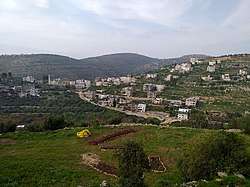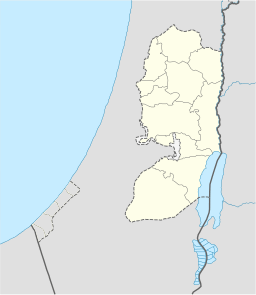Ein Qiniya
Ein Qiniya or 'Ayn Kiniya (Arabic: عين قينيا) is a Palestinian village in the northern West Bank, located 7 kilometers (4.3 mi) northwest of Ramallah and is a part of the Ramallah and al-Bireh Governorate. Ein Qiniya has existed since the Roman-era of rule in Palestine.[2] The village is very small with no public structures or institutions and is governed by a local development committee. Ein Qiniya is regionally notable for being a spring and autumn time picnic resort.[2]
Ein Qiniya | |
|---|---|
Local Development Committee | |
| Arabic transcription(s) | |
| • Arabic | عين قينيا |
| • Latin | Ayn Kiniya (official) Ein Qinya (unofficial) |
 Ein Qiniya 2019 | |
 Ein Qiniya Location of Ein Qiniya within Palestine  Ein Qiniya Ein Qiniya (the Palestinian territories) | |
| Coordinates: 31°55′37″N 35°08′56″E | |
| Palestine grid | 164/148 |
| State | State of Palestine |
| Governorate | Ramallah and al-Bireh |
| Government | |
| • Type | Local Development Committee |
| Population (2006) | |
| • Total | 817 |
| Name meaning | The crimson spring[1] |
There is an annual walk on March 4 from Ramallah to Ein Qiniyya in celebration of the spring.[3]
Location
'Ein Qiniya is located (horizontally) 5.5 km west of Ramallah. It is bordered by Ramallah to the east, Al-Zaitounah to the north, Al-Janiya and Deir Ibzi to the west, and Ein 'Arik and Beitunia to the south.[4]
History
A Middle Bronze Age tomb was discovered here in 1934.[5] Potsherds from the Hellenistic and Umayyad/Abbasid period have been found here.[5]
Ein Qiniya has traditionally been identified with Ainqune of the Crusader era, one of the fiefs given by King Godfrey to the Church of the Holy Sepulchre.[6][7] However, Finkelstein writes that this identification should be reconsidered.[8] Potsherds from the Mamluk era have also been found here.[5]
During the Mamluk era, it was stipulated that the whole of the revenue from Ein Qiniya should go to the Al-Tankiziyya (com) in Jerusalem. The building was completed in 1328-29.[9]
Ottoman era
In 1517, the village was included in the Ottoman empire with the rest of Palestine, and in the 1596 tax-records it appeared as Ayn Qinya, located in the Nahiya of Jabal Quds of the Liwa of Al-Quds. The population was 32 households, all Muslim. They paid a tax rate of 33.3% on agricultural products, which included wheat, barley, summer crops, olive trees, vineyards and fruit trees, occasional revenues, goats and beehives; a total of 4,760 akçe. 1/3 of the income went to a waqf.[10][11]
In 1838 it was noted as 'Ain Kinia, a Muslim village, located in the Beni Harith district, north of Jerusalem.[12]
An official Ottoman village list from about 1870 showed that Ain Kina had 54 houses and a population of 205, though the population count only included men.[13][14]
In 1882, the PEF's Survey of Western Palestine (SWP) described Ain Kanieh as "a village of moderate size on a ridge".[15]
In 1896 the population of 'Ain kinja was estimated to be about 135 persons.[16]
British Mandate era
In 1917, most of the village's inhabitants were evacuated by the British army on suspicion that residents killed a British officer. The residents were relocated to Beitunia and Yalo.[2] In the 1922 census of Palestine, conducted by the British Mandate authorities, 'Ain Qinia had a population of 56, all Muslims.[17] This had increased in the 1931 census to 83, still all Muslims, in a total of 26 houses.[18]
In the 1945 statistics the population was 100, all Muslims,[19] while the total land area was 2,494 dunams, according to an official land and population survey.[20] Of this, 1,276 were allocated for plantations and irrigable land, 569 for cereals,[21] while 19 dunams were classified as built-up (urban) areas.[22]
Jordanian era
In the wake of the 1948 Arab–Israeli War, and after the 1949 Armistice Agreements, Ein Qiniya came under Jordanian rule.
The Jordanian census of 1961 found 235 inhabitants.[23]
1967 and after
Since the Six-Day War in 1967 Ein Qiniya has been under Israeli occupation.
After the 1995 accords 12.1% of village land was classified as Area B, the remaining 87.9% as Area C.[24]
Israel has confiscated 157 dunams of village land in order to construct the Israeli settlement of Dolev.[25]
In 1982 residents numbered 101, then after a mass migration of other Palestinians to the Ein Qiniya, the population rose to 464 in 1984.[26] According to the Palestinian Central Bureau of Statistics, in 2006 it had a population of 807.[27] In the 2007 PCBS census, there were 817 people living in the village.[28]
References
- Palmer, 1881, p. 222
- Ein Qinya (The Spring of Qinya) - Ramallah Jerusalem Media and Communications Centre.
- Events Calendar Archived 2008-09-15 at the Wayback Machine Jerusalem Post.
- 'Ein Qiniya Village Profile, ARIJ, p. 4
- Finkelstein et al., 1997, p. 337
- de Roziére, 1849, p. 100
- Conder and Kitchener, 1883, SWP III, p. 11
- Röhricht, 1887, p. 204; Röhricht, 1893, RRH, p. 50, No 200; both cited by Finkelstein et al., 1997, p. 337
- Burgoyne, 1987, p. 225
- Hütteroth and Abdulfattah, 1977, p. 118
- Toledano, 1984, p. 289, has 'Ain Qinya located at 35°08′35″E 31°55′35″N
- Robinson and Smith, 1841, vol 3, Appendix 2, p. 124
- Socin, 1879, p. 143. It was also noted to be in the Beni Harit district
- Hartmann, 1883, p. 125 noted 52 houses
- Conder and Kitchener, 1882, SWP II, p. 295
- Schick, 1896, p. 123
- Barron, 1923, Table VII, Sub-district of Ramallah, p. 16
- Mills, 1932, p. 49
- Government of Palestine, Department of Statistics, 1945, p. 26
- Government of Palestine, Department of Statistics. Village Statistics, April, 1945. Quoted in Hadawi, 1970, p. 64
- Government of Palestine, Department of Statistics. Village Statistics, April, 1945. Quoted in Hadawi, 1970, p. 112
- Government of Palestine, Department of Statistics. Village Statistics, April, 1945. Quoted in Hadawi, 1970, p. 162
- Government of Jordan, Department of Statistics, 1964, p. 24
- 'Ein Qiniya Village Profile, ARIJ, p. 16
- 'Ein Qiniya Village Profile, ARIJ, p. 17
- Welcome to 'Ayn Kiniya
- Projected Mid -Year Population for Ramallah & Al Bireh Governorate by Locality 2004- 2006 Archived March 4, 2009, at the Wayback Machine Palestinian Central Bureau of Statistics.
- 2007 PCBS Census Archived December 10, 2010, at the Wayback Machine Palestinian Central Bureau of Statistics. p.114.
Bibliography
- Barron, J.B., ed. (1923). Palestine: Report and General Abstracts of the Census of 1922. Government of Palestine.
- Burgoyne, Michael Hamilton (1987). Mamluk Jerusalem. ISBN 090503533X.
- Conder, C.R.; Kitchener, H.H. (1882). The Survey of Western Palestine: Memoirs of the Topography, Orography, Hydrography, and Archaeology. 2. London: Committee of the Palestine Exploration Fund.
- Conder, C.R.; Kitchener, H.H. (1883). The Survey of Western Palestine: Memoirs of the Topography, Orography, Hydrography, and Archaeology. 3. London: Committee of the Palestine Exploration Fund.
- Finkelstein, I.; Lederman, Zvi, eds. (1997). Highlands of many cultures. Tel Aviv: Institute of Archaeology of Tel Aviv University Publications Section. ISBN 965-440-007-3.
- Government of Jordan, Department of Statistics (1964). First Census of Population and Housing. Volume I: Final Tables; General Characteristics of the Population (PDF).
- Government of Palestine, Department of Statistics (1945). Village Statistics, April, 1945.
- Hadawi, S. (1970). Village Statistics of 1945: A Classification of Land and Area ownership in Palestine. Palestine Liberation Organization Research Center.
- Hartmann, M. (1883). "Die Ortschaftenliste des Liwa Jerusalem in dem türkischen Staatskalender für Syrien auf das Jahr 1288 der Flucht (1871)". Zeitschrift des Deutschen Palästina-Vereins. 6: 102–149.
- Hütteroth, Wolf-Dieter; Abdulfattah, Kamal (1977). Historical Geography of Palestine, Transjordan and Southern Syria in the Late 16th Century. Erlanger Geographische Arbeiten, Sonderband 5. Erlangen, Germany: Vorstand der Fränkischen Geographischen Gesellschaft. ISBN 3-920405-41-2.
- Mills, E., ed. (1932). Census of Palestine 1931. Population of Villages, Towns and Administrative Areas. Jerusalem: Government of Palestine.
- Palmer, E.H. (1881). The Survey of Western Palestine: Arabic and English Name Lists Collected During the Survey by Lieutenants Conder and Kitchener, R. E. Transliterated and Explained by E.H. Palmer. Committee of the Palestine Exploration Fund.
- Robinson, E.; Smith, E. (1841). Biblical Researches in Palestine, Mount Sinai and Arabia Petraea: A Journal of Travels in the year 1838. 3. Boston: Crocker & Brewster.
- Rosière, de, ed. (1849). Cartulaire de l'église du Saint Sépulchre de Jérusalem: publié d'après les manuscrits du Vatican (in Latin and French). Paris: Imprimerie nationale.
- Röhricht, R. (1887). "Studien zur mittelalterlichen Geographie und Topographie Syriens". Zeitschrift des Deutschen Palästina-Vereins. 10: 195–344.
- Röhricht, R. (1893). (RRH) Regesta regni Hierosolymitani (MXCVII-MCCXCI) (in Latin). Berlin: Libraria Academica Wageriana. (Röhricht, 1893, RRH, pp. 16-17, No 74)
- Schick, C. (1896). "Zur Einwohnerzahl des Bezirks Jerusalem". Zeitschrift des Deutschen Palästina-Vereins. 19: 120–127.
- Socin, A. (1879). "Alphabetisches Verzeichniss von Ortschaften des Paschalik Jerusalem". Zeitschrift des Deutschen Palästina-Vereins. 2: 135–163.
- Toledano, E. (1984). "The Sanjaq of Jerusalem in the Sixteenth Century: Aspects of Topography and Population". Archivum Ottomanicum. 9: 279–319.
External links
- Welcome To 'Ayn Kiniya
- Survey of Western Palestine, Map 14: IAA, Wikimedia commons
- 'Ein Qiniya Village (Fact Sheet), Applied Research Institute–Jerusalem (ARIJ)
- 'Ein Qiniya Village Profile, ARIJ
- 'Ein Qiniya aerial photo, ARIJ
